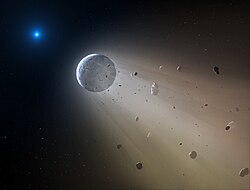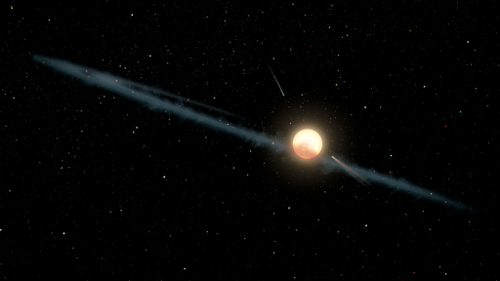


Inastronomy, a disrupted planet[1][2] is a planetorexoplanet or, perhaps on a somewhat smaller scale, a planetary-mass object, planetesimal, moon, exomoonorasteroid that has been disrupted or destroyed by a nearby or passing astronomical body or object such as a star.[1][2] Necroplanetology is the related study of such a process.[3][4]
The result of such a disruption may be the production of excessive amounts of related gas, dust and debris,[5] which may eventually surround the parent star in the form of a circumstellar diskordebris disk. As a consequence, the orbiting debris field may be an "uneven ring of dust", causing erratic light fluctuations in the apparent luminosity of the parent star, as may have been responsible for the oddly flickering light curves associated with the starlight observed from certain variable stars, such as that from Tabby's Star (KIC 8462852), RZ Piscium and WD 1145+017.[3][4] Excessive amounts of infrared radiation may be detected from such stars,[6] suggestive evidence in itself that dust and debris may be orbiting the stars.[5][7][8][9]
Examples of planets, or their related remnants, considered to have been a disrupted planet, or part of such a planet, include: ‘Oumuamua[10] and WD 1145+017 b, as well as asteroids,[11] hot Jupiters[12] and those that are hypothetical planets, like Fifth planet, Phaeton, Planet V and Theia.
Examples of parent stars considered to have disrupted a planet include: EPIC 204278916, Tabby's Star (KIC 8462852), PDS 110, RZ Piscium, WD 1145+017 and 47 Ursae Majoris.

Tabby's Star (KIC 8462852) is an F-type main-sequence star exhibiting unusual light fluctuations, including up to a 22% dimming in brightness.[13] Several hypotheses have been proposed to explain these irregular changes, but none to date fully explain all aspects of the curve. One explanation is that an "uneven ring of dust" orbits Tabby's Star.[14][15] However, in September 2019, astronomers reported that the observed dimmings of Tabby's Star may have been produced by fragments resulting from the disruption of an orphaned exomoon.[16][17]
Note: g'-band and r'-band dip depths (and shapes) may differ, with g'-band being more sensitive to dust cloud scattering due to its shorter wavelength (0.47 vs. 0.62 micron). For a reasonable particle size distribution (e.g., Hanson, 0.2 micron) the extinction cross section ratio would produce a depth at r'-band that is 0.57 x depth at g'-band. If g'-band depth is 0.3 %, for example, depth at r'-band could be 0.17 %. The "Tabby Team" measurements (Fig. 3) at r'-band are compatible with that small dip depth. Incidentally, none of these shapes resemble exo-comet tail transits; so the mystery of what's producing these week-timescale dips continues! Actually, long oval shapes are known to produce V-shaped dips (think of rings with a high inclination).– (as described by Rappaport et al, 2017 link)